last modified on April 20, 2005
During 1933, the Polikarpov team began to work on an advanced single-seat
fighter with a water-cooled engine and a top speed target of 500 km/h;
it was estimated that a radial engine of contemporary design could not
allow more than 450 km/h top speed.
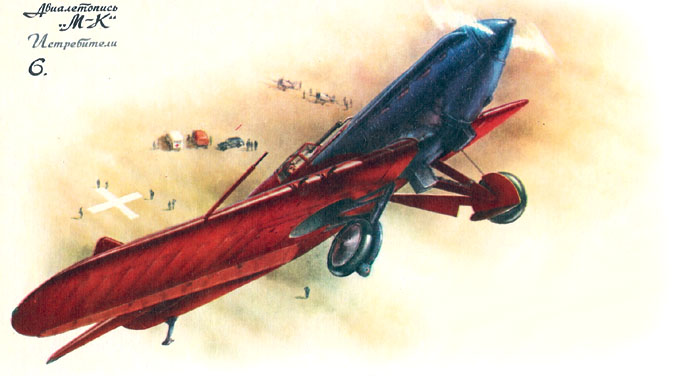 |
The first prototype, called TsKB-15, was flown on 1 September
1934 with a 760 hp Hispano-Suiza 12Ybrs engine.
This was a low wing cantilever monoplane with manually outward retractable
main undercarriage and forward sliding canopy.
The TsKB-15 reached a speed of 455 km/h in level flight and climbed
to 5,000 m in 6.5 min. This performance was quite high for the time, even
if lower than the target figures. As well, stability and controllability
were judged to be better than on the I-16.
TsKB-15 was put into the in V.P.
Chkalov museum in 1940.
The aircraft is on display there, still in its original colors.
go to TsKB-15
|
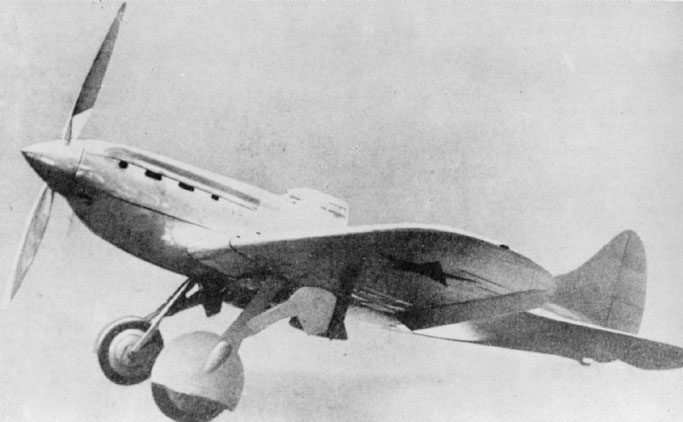 |
The second prototype, named TsKB-19, was flown in the
spring of 1935.
It differed from the TsKB-15 for undercarriage, nose shape, underwing
retractable coolers, shorter ailerons and the presence of flaps.
The TsKB-19 reached a horizontal maximum speed of 485 km/h.
It was exposed in Paris Air Show in 1936 and Milan Air Show in 1937.
It was conserved till late '80s in Central Aerospace Museum of Moscow,
but its fate is unknown now.
go to TsKB-19
|
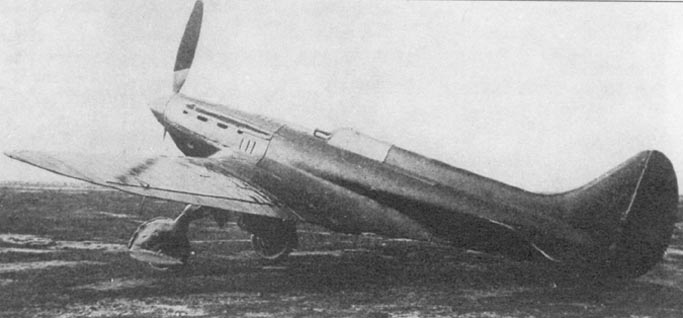 |
A third prototype, TsKB-19 bis or I-17 bis, was built and flown
in late 1936.
It was nearly identical to the second prototype, differing for its
rear-sliding canopy separated from the windshield, and for being armed
with a 20 mm ShVAK gun firing from the propeller axis and two 7,62 ShKAS
machine guns on wings.
The aircraft was used for armament trials, and then modified adding
an auxiliary radiator and removing undercarriage doors.
go to TsKB-19bis
|
A fourth prototype, TsKB-33, was provided with surface evaporation
steam cooling instead of radiators to improve its aerodynamics.
The exchange surfaces occupied an area of about 7 sq.m on the nose,
leading edge and upper surface of the wing.
It was armed with only 3 ShKAS 7.62 mm guns so as to limit its gross
weight to 1935 kg.
In this form it was able to reach a speed of over 500 km/h, but it
was not accepted because of its high vulnerability in combat.
According to some sources, the prototype costruction was halted before
completion; other sources say it was flown, but none image is known.
A project which never materialized, I-17Z, considered the use
of a modified TsKB-33 with wing area reduced to 9 sq.m and without a normal
undercarriage, armed with heavy gun, designed to reach 575 km/h and launched
by a Zveno TB-3.
The suspension system was designed by V.S. Vachmistrov.
I-17Z had hook to hitch under TB-3 and landing ski for emergency landing
(probably like Me-163). (see drawing aside) |
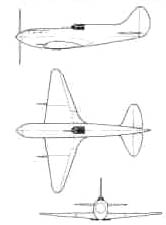 |
 |
A fifth prototype, TsKB-25 (I-19) , powered by a Gnome-Rhone
14 K radial engine (calculated speed = 475 km/h) was never built.
Due to radial engine, its shape was closer to that of I-16 than of
I-17. (see drawing aside)
A sixth prototype, TsKB-43, with an Hispano-Suiza 12 ycrs motor
(calculated speed = 520 km/h), was also never built.
According to some
sources, in 1937 Polikarpov designed the I-172 powered by a
Klimov M-105, but this engine would not be ready for a long time.
From late 1938 Polikarpov developed another variant with the M-105,
named
I-173.
In early 1939 all activity on these projects ceased, because the Soviet
authorities asked N.N. Polikarpov to concentrate his efforts on air-cooled
radial-engined prototypes, such as the promising (and ill-fated) I-180.
The designer searched for an "ecological niche " for his in-line powered
machines, and one direction was the installation on I-173 of heavy gun
armament, which led to the creation of the Polikarpov ITP fighter
prototype.
Another direction was the creation of a high-altitude fighter with
a powerful Mikulin engine, and this led to the Project K, which
was developed by Mikoyan and Gurevich into the I-200 (MiG-1 and MiG-3). |
According to the great
book written by eng. Shavrov, TsKB-19 showed better flight characteristics
and performance than the contemporary I-16, but a major problem was the
very tight cockpit (due to the small cross-section for minimizing drag).
Only small pilots would fit in the cockpit and be able to operate the controls
normally. Besides, the closed canopy was not loved by Soviet pilots, who
preferred the possibility to protrude their heads. An identical canopy,
mounted on I-16 Type 5, was replaced by an open windshield on the Type
10 and later.
The Soviet Air Force leaders thought that the I-16 was adequate for
its time, perhaps even too fast and difficult in landing for the average
Soviet pilot of the period, accustomed to forgiving biplanes. This conservative
decision was not far-seeing. The I-17 anticipated aircraft such as the
Hurricane, Me-109 and Spitfire, by at least two years. The technological
advantage obtained with the I-16 and I-17 was lost by the end of Spanish
Civil War.
As time showed, the basic parameters of the I-17 were essentially correct,
and its form was successful. Its speed and powerful armament were unmatched
in 1934. However, due to the lack of power of the in-line engines of 1934,
the speed of 500 km/h could be obtained only by sophisticated cooling devices
and sacrificed cockpit size. Besides, aircraft in 1935 were not well armored,
and its large gun was not seen to be necessary.
When, in 1938, water-cooled engines in the class of 1050 hp appeared,
aircraft comparable to the I-17 with better performance and fewer compromises
appeared rapidly in many countries, but the USSR began to create new aircrafts
of this class only in late 1939.
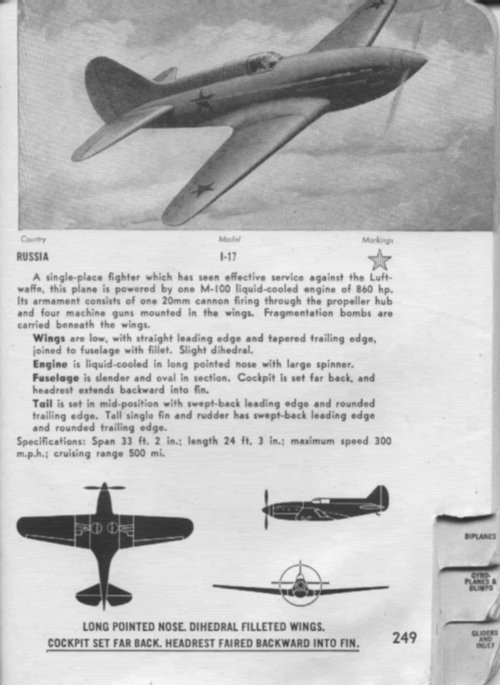 |
Some souces report a series construction of the aircraft and its participation
in the fight against the Japanese at Nomonhan in 1939, and in the early
stages of the Great Patrioctic War in 1941. However, these claims are without
any foundation, and series manufacture of the I-17 never took place.
Even many Finnish pilots claimed to have shot down some "I-17s", but
this was probably confusion with MiG-1 and MiG-3 fighters.
This page from an old book represents a sum of what many believed about
the I-17. |
 |
The image below is manipulated to show hypothetical operative I-17s
just before the war, with open cockpit as the I-16s.
I like to imagine them in this manner. |
I would like to thank Audrius Nairanauskas,
Axel
Fischer, Ekzot aka Sergey,
Greg
Reynolds,
Igor Shestakov,
Jouni
Ronkko,
Kristjan Runarsson
,
Ilya
Grinberg, Libor Spurek, Matthias
Erben and Thomas
Siepert for their contributions that made possible this work.
Audrius, in particular, has sent to me as a gift the Aviacia n.12 magazine,
with a work of Mikhail Maslov that is the best reference on this subject
till now.
Any photo, drawing or notice, both of historical, technical and modeling
nature is welcome.
Eventual comments and contributions can be addressed to Massimo
Tessitori.






